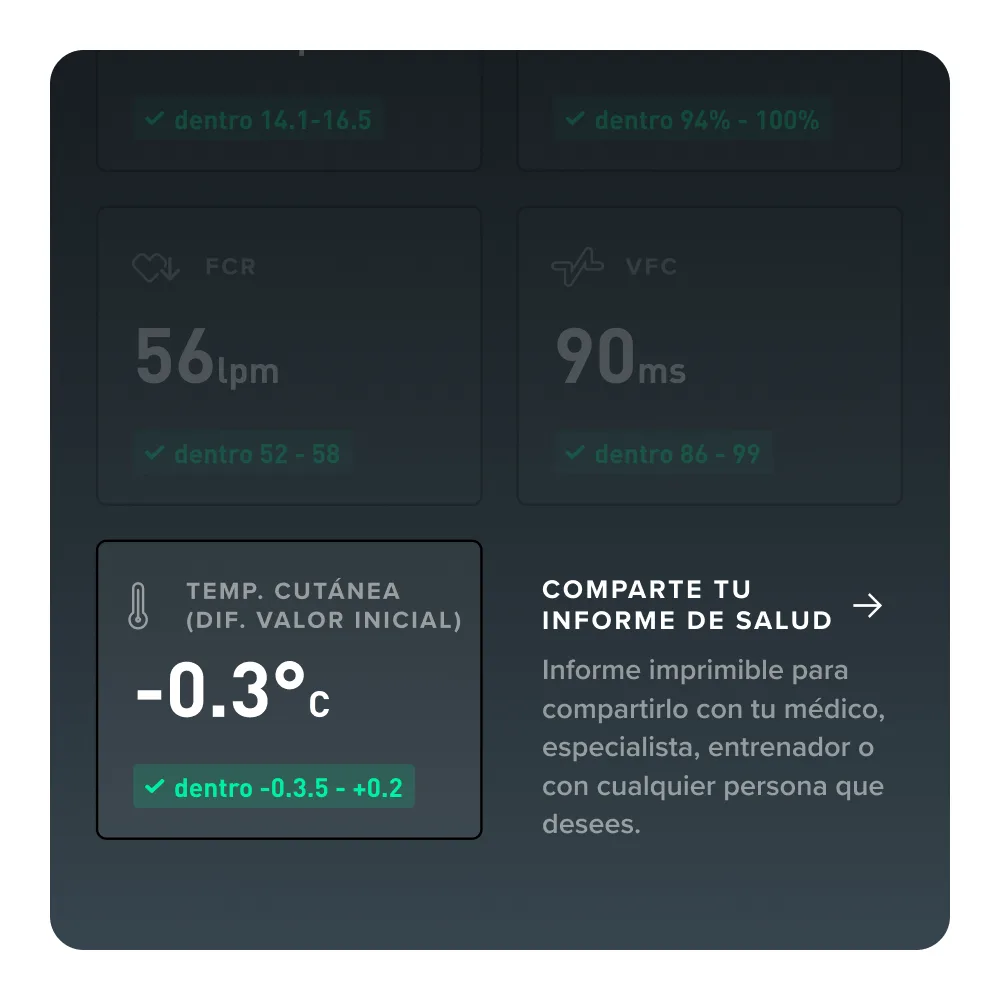¿Qué es la temperatura cutánea y por qué debes monitorearla?

La temperatura cutánea juega un papel importante para regular su temperatura corporal y puede incrementar o disminuir diariamente. Aprende cómo monitorear tu temperatura cutánea puede ayudarte a entender mejor tu cuerpo.
La temperatura cutánea es una medición del calor en la superficie exterior de tu cuerpo. Puede ser significativamente menor que la temperatura interna de las extremidades y miembros.
¿Cuál es la temperatura cutánea normal?
La temperatura cutánea normal para adultos saludables va desde 92.3 y 98.4°F o 33-37°C, mucho menor que la temperatura interna de 98.6°F. Los cambios en esta temperatura pueden indicar enfermedades o lesiones potenciales.
Cómo ayuda la piel a regular la temperatura corporal
Tu piel es tu órgano más grande, conformando aprox. el 15% de tu peso total. El volumen de la superficie de la piel significa que hay variaciones regionales en la temperatura. La piel de tus dedos de las manos y pies puede ser drásticamente menor que la temperatura tomada en tu frente. Al tener tan gran volumen de superficie significa que tu piel juega un papel significativo para regular la temperatura corporal. Esto se llama termoregulación y permite que tu cuerpo preserve el calor o lo descargue en base a sus necesidades. Por ejemplo, conforme te acercas a tu hora habitual para dormir, tu ciclo de ritmo circadiano prepara tu cuerpo al llevar calor desde el centro, ralentizando tu nivel de actividad y bajando tu metabolismo. Esta acción permite que tu temperatura interna descienda lentamente, comenzando el ciclo de sueño, y prepara el cuerpo para otros procesos naturales como producción de hormonas, regeneración celular y respuestas del sistema inmune. Adicionalmente en condiciones frías, tu cuerpo puede deshacerse del calor de la piel para mantener la temperatura interior estable.
¿Qué significa una temperatura cutánea alta o baja?
La temperatura cutánea alta puede indicar fiebre o enfermedad, pero simplemente puede significar que estás demasiado cerca de una fuente de calor, o te has cubierto con demasiadas cobijas mientras dormías. El ejercicio también puede afectar temporalmente la temperatura cutánea . Una temperatura cutánea significativamente baja puede significar que estás sufriendo de hipotermia, y el cuerpo está llevando el calor de la superficie para mantener alta la temperatura interna. Pero las temperaturas cutáneas bajas también pueden ser menos graves. Podrías estar en una habitación fría o demasiado cerca de un aire acondicionado.
Monitoreando temperatura cutánea con WHOOP 4.0
WHOOP 4.0 incluye un sensor de temperatura cutánea que te permite monitorear tu temperatura cutánea diaria en la nueva función Monitor de salud. WHOOP usa tus datos de 90 noches previas para personalizar una línea base para tu temperatura cutánea. Puedes usar los datos en conjunto con el Planificador de sueño para experimentar con factores mientras duermes para ver si esos cambios te ayudan a dormir confortablemente. Por ejemplo, si tus registros de temperatura cutánea son altos, deberías considerar quitar una cobija o encender un ventilador. El Monitor de salud te permite ver todas tus métricas personales en una sola ubicación, incluyendo temperatura cutánea, frecuencia cardiaca en vivo, HRV, frecuencia cardiaca en reposo, oximetría de pulso y frecuencia respiratoria.

EL MONITOR DE SALUD WHOOP 4.0 TE PERMITE VER TU TEMPERATURA CUTÁNEA Y OTROS MÉTRICOS FISIOLÓGICOS EN UN SOLO LUGAR.
Los productos y servicios de WHOOP no son dispositivos médicos, no están diseñados para diagnosticar el COVID-19, la influenza o cualquier otra enfermedad, y no deben ser usados como un substituto de un consejo médico profesional, un diagnóstico o un tratamiento. Todo el contenido disponible a través de los productos y servicios de WHOOP es únicamente para información general.